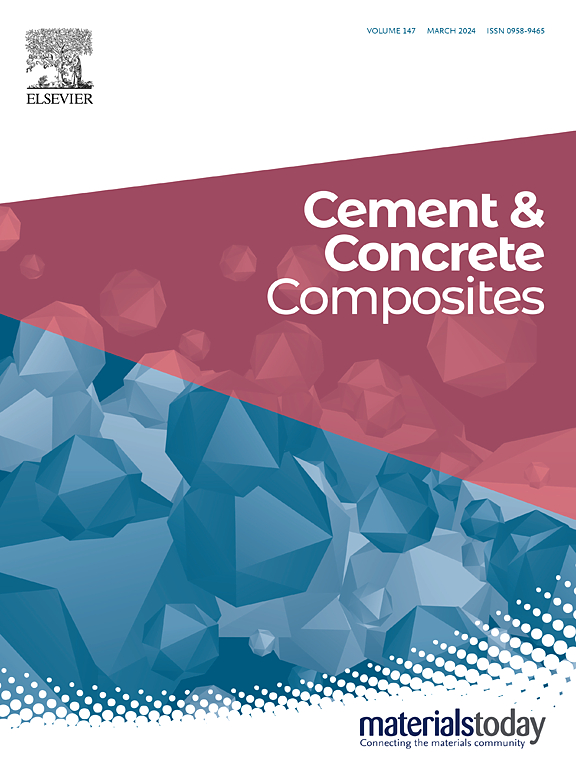Enhancing nano-CaCO3 dispersion with cellulose nanocrystals for high-strength low-carbon concrete
IF 13.1
1区 工程技术
Q1 CONSTRUCTION & BUILDING TECHNOLOGY
引用次数: 0
Abstract
To produce low-carbon concrete, nano calcium carbonate (nano-CaCO3) has been used as a partial cement replacement to enhance concrete properties through nucleation and filler effects. The nano-CaCO3 is being synthesized by reacting CO2 with calcium-rich natural and/or waste materials. However, a critical challenge in this approach is the poor dispersion of nano-CaCO3 which tends to agglomerate due to van der Waals forces. This agglomeration severely affects the mechanical performance and durability of concrete, particularly at higher dosages.
This study introduces a novel solution to enhance nano-CaCO3 dispersion by leveraging cellulose nanocrystals (CNC) and their abundant hydroxyl functional groups. Nano-CaCO3 was synthesized via the carbonation of calcium hydroxide (Ca(OH)2) suspension in the presence of CNC and incorporated into cement paste at up to 0.9 % replacement. The results demonstrate significant advancements: (1) CNC markedly improves nano-CaCO3 dispersion in both water and cement paste; (2) CNC-incorporated synthesis reduces nano-CaCO3 crystallinity which may provide more nucleation sites due to higher surface area; (3) while pure calcite forms in the absence of CNC, its presence promotes additional polymorphs, including aragonite and vaterite, and (4) well-dispersed nano-CaCO3 achieved with CNC leads to a substantial 52 % increase in compressive strength and a 30 % increase in flexural strength. This research introduces an innovative strategy to overcome nano-CaCO3 dispersion challenges for scaling production, enabling its effective use in cementitious materials and significantly enhancing concrete performance.
纤维素纳米晶增强纳米碳酸钙在高强低碳混凝土中的分散
为了生产低碳混凝土,纳米碳酸钙(纳米caco3)被用作部分水泥替代品,通过成核和填充作用来增强混凝土的性能。纳米碳酸钙是由二氧化碳与富含钙的天然和/或废料反应合成的。然而,这种方法的一个关键挑战是纳米caco3的分散性差,由于范德华力的作用,纳米caco3容易聚集。这种结块严重影响混凝土的机械性能和耐久性,特别是在较高的剂量下。本研究介绍了一种利用纤维素纳米晶体(CNC)及其丰富的羟基官能团来增强纳米caco3分散的新方法。在CNC的存在下,通过氢氧化钙(Ca(OH)2)悬浮液的碳化合成纳米caco3,并以高达0.9%的替代率掺入水泥浆中。结果表明:(1)CNC显著改善了纳米caco3在水和水泥浆中的分散;(2) cnc合成降低了纳米caco3的结晶度,使得纳米caco3的表面积增大,可以提供更多的成核位;(3)虽然在没有CNC的情况下形成了纯方解石,但它的存在促进了额外的多晶体,包括文石和水晶石。(4)通过CNC获得的分散良好的纳米caco3导致抗压强度增加52%,弯曲强度增加30%。本研究介绍了一种创新的策略来克服纳米caco3分散在结垢生产中的挑战,使其能够有效地用于胶凝材料并显着提高混凝土性能。
本文章由计算机程序翻译,如有差异,请以英文原文为准。
求助全文
约1分钟内获得全文
求助全文
来源期刊

Cement & concrete composites
工程技术-材料科学:复合
CiteScore
18.70
自引率
11.40%
发文量
459
审稿时长
65 days
期刊介绍:
Cement & concrete composites focuses on advancements in cement-concrete composite technology and the production, use, and performance of cement-based construction materials. It covers a wide range of materials, including fiber-reinforced composites, polymer composites, ferrocement, and those incorporating special aggregates or waste materials. Major themes include microstructure, material properties, testing, durability, mechanics, modeling, design, fabrication, and practical applications. The journal welcomes papers on structural behavior, field studies, repair and maintenance, serviceability, and sustainability. It aims to enhance understanding, provide a platform for unconventional materials, promote low-cost energy-saving materials, and bridge the gap between materials science, engineering, and construction. Special issues on emerging topics are also published to encourage collaboration between materials scientists, engineers, designers, and fabricators.
 求助内容:
求助内容: 应助结果提醒方式:
应助结果提醒方式:


